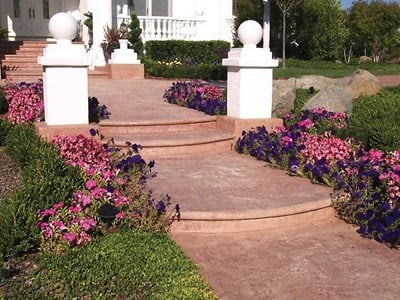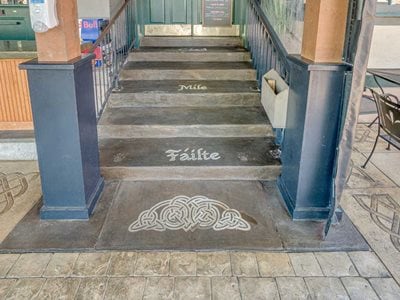
Stamped concrete steps add value to stamped concrete projects. Texturing stairs adds to the cohesiveness of the design. It reduces the surfaces that look like plain concrete. If done properly, this makes an overall better looking project. Texturing stairs also creates opportunities for multi-level stamped concrete patios, pool decks, and sidewalks.
There are two parts to stamped concrete steps. The tread is the part of the step you walk on. The face or riser is the vertical surface of the step. Both of these can be textured and colored to match stamp concrete patterns elsewhere on the project. With a little extra work and material, you can dramatically improve the project quality.
Use form liners to texture the riser. Form liners are specialized texturing tools designed to texture vertical cast concrete surfaces. Attach the liner to the wooden form, apply liquid release, and pour the concrete. During this process, it is important to vibrate the concrete to consolidate and get better texture. When the concrete has set, strip the forms like usual. After the forms are removed, the step face will have a detailed impression.
Traditional concrete stamps can be used on the tread. This means you can continue whatever pattern you are using elsewhere onto the steps. In most cases, it is best to use a seamless skin or the "floppy" version of the patterned stamp. Regular stamps are often too stiff to easily use on a narrow stair tread. The flexible floppy textures can more easily texture into corners and other tight areas. Use a texture skin if you do not have floppy that matches your concrete stamp.

Integral color is the best choice for concrete steps. These pigments color the concrete throughout, meaning all visible faces of the concrete will have the same color. You can focus your efforts on forming, finishing, and texturing the concrete. Use colored release for accent on the textured portion of the steps. Water-based stains are also an easy way to add highlights and adjust color. These are the most effective options for coloring concrete steps.
Decorative concrete should always be sealed. This protects the concrete from stains and enhances color. Some sealers also repel water. When selecting a sealer for stamped concrete steps, consider a traction additive. This reduces the risk of slipping when the stairs are wet. This is especially important near pools. Use a sprayer to apply most sealers. A sprayer works best because it yields better coverage and faster drying. The concrete steps should be periodically inspected and sealed again as necessary.
Stamped concrete steps are often forgotten. The benefit to texturing steps is far greater than the additional effort. it does not take much to stamp the tread or texture the riser. But that little bit of work can turn a basic project into a premium product.
Explore impressive concrete installations to find inspiration for your next project.
Find out how much color and fiber you'll need for any size project.